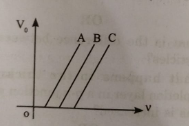Photoelectric effect
When light of sufficiently small wavelength is incident on a metal cathode, it may emit electsons called photoelectrons. This is called photoelectric effect. Above threshold frequency, the stopping potential and hence the energy of the photoelectrons is directly proportional to the frequency.
Slope of graph is given by Solution in Punjabi
he
eh
he
1he
Step by step video & image solution for Photoelectric effectWhen light of sufficiently small wavelength is incident on a metal cathode, it may emit electsons called photoelectrons. This is called photoelectric effect. Above threshold frequency, the stopping potential and hence the energy of the photoelectrons is directly proportional to the frequency. Slope of graph is given by by Physics experts to help you in doubts & scoring excellent marks in Class 12 exams.
Updated on:21/07/2023Similar Questions
The photoelectric threshold frequency of a metal is v, when light of frequency 4v is incident on the metal, the maximum kinetic energy of the emitted photoelectron is:
View SolutionPhotoelectric effect When light of sufficiently small wavelength is incident on a metal cathode, it may emit electsons called photoelectrons. This is called photoelectric effect. Above threshold frequency, the stopping potential and hence the energy of the photoelectrons is directly proportional to the frequency. In the given figure, we see the variation of stopping potential with the frquency of incident radiation for three metals A, B and C Which metal has the largest threshold wavelength?
View SolutionPhotoelectric effect
When light of sufficiently small wavelength is incident on a metal cathode, it may emit electsons called photoelectrons. This is called photoelectric effect. Above threshold frequency, the stopping potential and hence the energy of the photoelectrons is directly proportional to the frequency. In the given figure, we see the variation of stopping potential with the frquency of incident radiation for three metals A, B and C
Which of these metals A, B or C are suitable for photoelectric cell?
View SolutionPhotoelectric effect When light of sufficeintly small wavelength is incident on a metal cathode, it may emit electons called photoelectrons. Above threshold frequency the stopping potenital and hence the energy of the photoelectrons are directly proportional to the frequency. in the given figure, we see the variation of stopping potential with the frequency of incident radiation for three metals A, B and C. Which metal has the largest threshold wavelenght?
View SolutionPhotoelectric effect
When light of sufficeintly small wavelength is incident on a metal cathode, it may emit electons called photoelectrons. Above threshold frequency the stopping potenital and hence the energy of the photoelectrons are directly proportional to the frequency. in the given figure, we see the variation of stopping potential with the frequency of incident radiation for three metals A, B and C.
Slope of graph is given by
View SolutionPhotoelectric effect When light of sufficeintly small wavelength is incident on a metal cathode, it may emit electons called photoelectrons. Above threshold frequency the stopping potenital and hence the energy of the photoelectrons are directly proportional to the frequency. in the given figure, we see the variation of stopping potential with the frequency of incident radiation for three metals A, B and C. Which of these metals A, B or C are suitable for photoelectric cell?
View SolutionThe photoelectric threshold frequency of a metal is v0. When ligth of frequency 3v0 is incident on the metal, the maximum kinetic energy of emitted photoelectrons will be
View Solution

